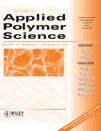Flame retardancy and dielectric properties of dicyclopentadiene-based benzoxazine cured with a phosphorus-containing phenolic resin
Abstract
A dicyclopentadiene-based benzoxazine (DCPDBZ) was prepared and separately copolymerized with melamine–phenol formaldehyde novolac or phosphorus-containing phenolic resin (phosphorus-containing diphenol) at various molar ratios. Their curing behaviors were characterized by differential scanning calorimetry. The electrical properties of the cured resins were studied with a dielectric analyzer. The glass-transition temperatures were measured by dynamic mechanical analysis. The thermal stability and flame retardancy were determined by thermogravimetric analysis and a UL-94 vertical test. These data were compared with those of bisphenol A benzoxazine and 4,4′-biphenol benzoxazine systems. The effects of the diphenol structure and cured composition on the dielectric properties, moisture resistance, glass-transition temperature, thermal stability, and flame retardancy are discussed. The DCPDBZ copolymerized with phosphorus-containing novolac exhibited better dielectric properties, moisture resistance, and flame retardancy than those of the melamine-modified system. The flame retardancy of the cured benzoxazine/phosphorus-containing phenolic resins increased with increasing phosphorus content. The results indicate that the bisphenol A and 4,4′-biphenol systems with a phosphorus content of about 0.6% and the dicyclopentadiene system with a phosphorus content of about 0.8% could achieve a flame-retardancy rating of UL-94 V-0. © 2008 Wiley Periodicals, Inc. J Appl Polym Sci, 2008




